Seven Questions Over Breakfast with Shadra Strickland
 November 8th, 2011 by jules
November 8th, 2011 by jules
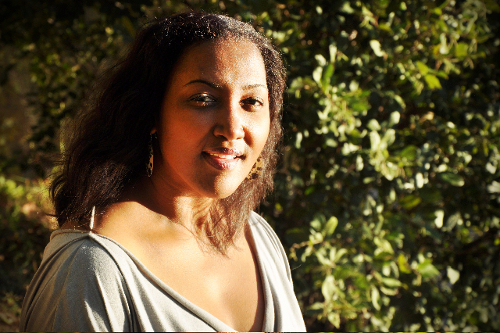
In all the many breakfast interviews I’ve conducted here in my own corner of cyberspace, I’m fairly certain I have never had an interviewee dish out two breakfasts at my 7-Imp cyber-table. But oh gracious, what a treat! Illustrator Shadra Strickland is here, and she has the following to say about what we’ll eat during our breakfast chat this morning:
I recently moved to Maryland, so my new breakfast of choice is crab cake benedict (poached eggs atop crab cakes over fried green tomatoes with hollandaise sauce) with coffee. My absolute favorite breakfast is fried cheese grits with biscuits at Enid’s.
And here are our choices:
You see, I’m good with both, especially the coffee part, and I think we should eat just about as much as we talk today.
I should confess that I’ve been pestering Shadra for years to come visit 7-Imp (she’s a busy lady), so I’m pleased she’s here this morning. If, by some chance, you’re not familiar with her work, I’m happy to be introducing you to it today. Shadra—who studied design, writing, and illustration at Syracuse University and later went on to complete her M.F.A. at the School of Visual Arts in New York City—was the 2009 recipient of the Ezra Jack Keats Award and the Coretta Scott King/John Steptoe Award for New Talent for the illustrations in her debut picture book, Zetta Elliott’s Bird. Since her moving mixed-media illustrations in Bird, artwork Kirkus described as “powerful” in their starred review, I’ve been watching Shadra’s career with interest. And, since Bird, she’s gone on to create the illustrations for a handful of additional picture books, all discussed below.
Her latest illustrated title is written by Michael S. Bandy and Eric Stein and is called White Water (Candlewick, August 2011), a story of a young boy in 1960s’ Alabama becoming acutely aware of the discrimination surrounding him:
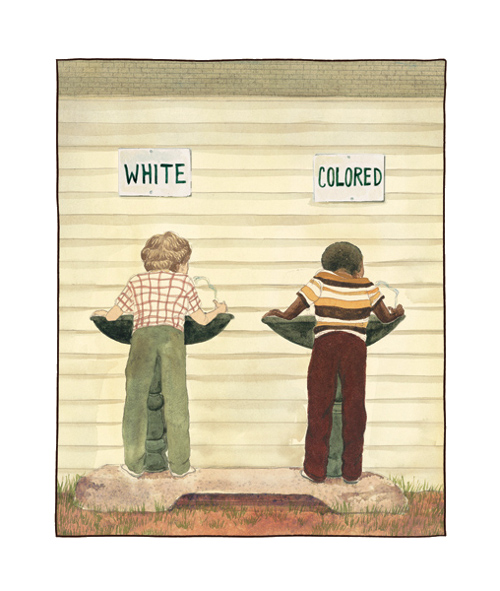
I thank Shadra for visiting and especially for the time she took to so generously answer questions and share images. She even created, you’ll see below, a video for 7-Imp about her process, and for that I was extra squealy-happy.
Without further ado …
Jules: Are you an illustrator or author/illustrator?
Shadra: I write also, but have not been able to focus fully enough to do both yet. Eventually, I would like to explore some of my own ideas as well. Though I do hope to publish my own picture books in the future, I think I’d really enjoy writing essays, short stories, illustrated novels, and how-to books and articles.
I think all artists feel they can do anything creative. Romare Bearden once said in an interview about his foray into songwriting, “…if you don’t think this way, there’s no use being an artist . . . that you can do anything.” I love that. It’s so true.
Jules: Can you list your books-to-date?

Shadra: {Zetta Elliott’s} Bird, Our Children Can Soar, {Renée Watson’s} A Place Where Hurricanes Happen, {Jerdine Nolen’s} Eliza’s Freedom Road (cover), {Michael S. Bandy and Eric Stein’s} White Water.
Jules: What is your usual medium, or––if you use a variety—your preferred one?
Shadra: I have painted in acrylic, watercolor, and oil, but it wasn’t until I began mixing media that I found my stride. I use watercolor and gouache primarily, but I like to play with other types of media alongside my tried and true. I am experimenting with collage for my current project, Sunday Shopping. Trying new things keeps me motivated and excited artistically. Plus, different stories call for different treatments. What I did with charcoal, ballpoint pen, and watercolor for a modern story like Bird wouldn’t work for a book like White Water that takes us back to the 1950s, where I worked pretty traditionally on sepia-toned paper.
I love working on Stonehenge paper with ink washes and gel pen. Some of my favorite illustrations were made this way, like “Lineage” and my kite series. I still try and make those images for fun to send out as promos every now and then. {Ed. Note: Shadra’s “kite series” is pictured lower in the interview.}
 Jules: If you have illustrated for various age ranges (such as, both picture books and early reader books OR, say, picture books and chapter books), can you briefly discuss the differences, if any, in illustrating for one age group to another?
Jules: If you have illustrated for various age ranges (such as, both picture books and early reader books OR, say, picture books and chapter books), can you briefly discuss the differences, if any, in illustrating for one age group to another?
Shadra: My very first book was an emergent reader book with Lee and Low, called Big or Little? {Ed. Note: An illustration from that is pictured left.} I was fresh out of undergrad and thought, “Yes! This is my big break.” I was ready to unleash all of my creative tricks, but my editor had to really pull me in, because emergent readers are very simple stories where the illustrations have to follow the text exactly. Any deviation would confuse readers.
Picture books give me freedom to interpret the story in my own way. I can add elements that aren’t necessarily in the text, and I have plenty of room to develop the story. Because I have more experience at making books now, my approach to illustrating an emergent reader would be much different than when I was starting out.
Jules: Where are your stompin’ grounds?
Shadra: The short answer: Baltimore, Maryland.
The long answer: I lived in New York from 2003-2009. Artistically, they were six of the greatest years of my life. There I met my advisor, Pat Cummings; worked as a designer at a major publishing house; worked for Christopher Myers; met my agent, Lori; hung out with fabulous designers, art directors, and editors; cut my art teeth with an amazing group of talented SVA grads; and had many other fabulous NYC adventures.
In 2010 I left NY to be with my family after suffering a significant loss. While I was at home, there were two more losses. It was a stressful time artistically, and though I was glad to be at home with my family, I learned that my environment is just as vital to my art as the proper tools. Thankfully, I met a host of wonderful librarians, artists, and art supporters who helped me stay positive and excited about my work. Greg Christie was also in Atlanta at the time, and I was able to develop a friendship with him and see his amazing work up close! Thanks, in part, to his recommendation, I started teaching illustration at Maryland Institute College of Art at the end of August.
The journey is the best part.
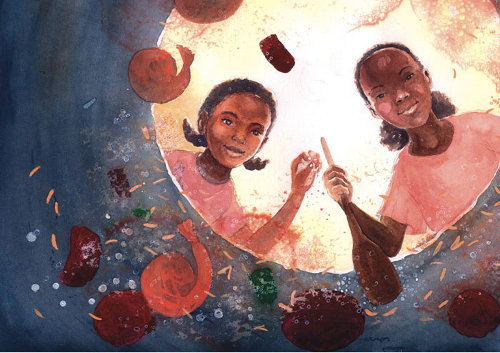
jambalaya with corn bread. / And I get to help…”
I am scared too.”
(Click to enlarge spread.)
(Click to enlarge.)
(Click to super-size and see better.)
Jules: Can you briefly tell me about your road to publication?
Shadra: * Submission * Rejection * Growth * Repeat * Preparation *Opportunity * Bird.
My road to publication was full of hard work and chance encounters. After graduating from Syracuse, I moved home to Atlanta to teach elementary school art under a three-year provisional. During that time, 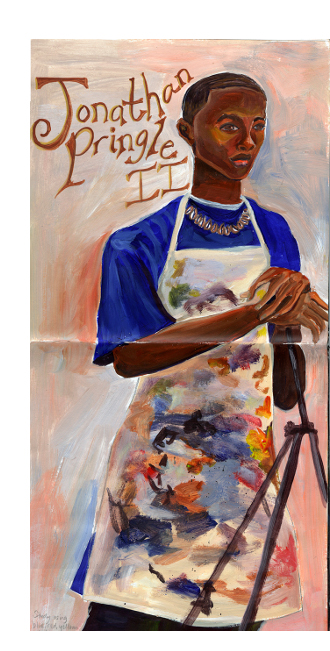 I worked on private commissions, public art with the city, and I illustrated my very first emergent reader with Jennifer Fox at Lee and Low.
I worked on private commissions, public art with the city, and I illustrated my very first emergent reader with Jennifer Fox at Lee and Low.
From there, I was accepted into SVA’s M.F.A. Illustration as Visual Essay Program and moved to NYC. During school, I interned at Penguin and taught at an after-school program in Chinatown. I also teamed up with fellow students and took my portfolio around to as many art directors and editors as I could, specifically meeting those who encouraged me when I first began submitting postcards after college. I came close to having a project accepted a few times, but never a solid “yes.” My friends went on to get manuscripts to illustrate, and I continued to wait.
During my thesis year, I worked with Pat Cummings the Great. (“The Great” should be permanently attached to her name.) Thanks to her help, I took on a job designing reprints for BloomsburyUSA part time and assisting Chris Myers a few days a week. Both of those opportunities were extensions of my education as a bookmaker. I continued to send out mailers and e-promos during the year. My art homies never stopped encouraging me.
A year later, I attended the Society of Illustrators Original Art show. Jen, my editor of Big or Little?, was standing next to me looking over artwork. We greeted each other and she said, “Shadra, come and see me. I think I have something for you.” I took my portfolio down to her office on one of the coldest days of February. When I got home, I followed up with an e-mail and she followed up by offering me Bird.
The rest is history!
(Click to enlarge third one)
And that includes you.'”
(Click to enlarge and see with text)
(Click to enlarge)
they just spread their wings / and soar.”
(Click to enlarge)
(Click to enlarge)
Jules: Can you please point readers to your web site and/or blog?
Shadra: www.shadrastrickland.com and www.facebook.com/ShadraTheArtist.
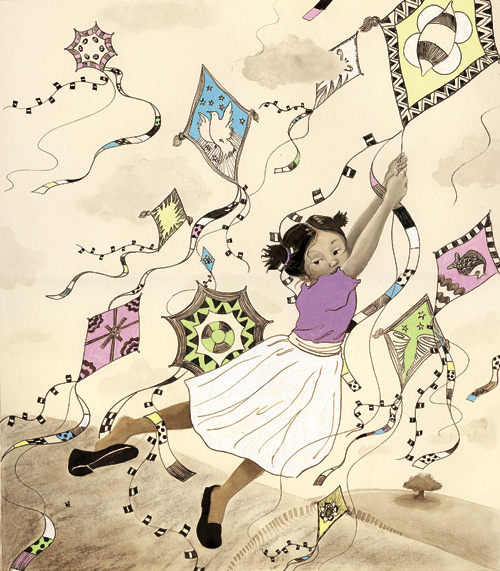

Jules: If you do school visits, tell me what they’re like.
Shadra: My school visits vary. For older students (high school and older), I usually give a PowerPoint presentation of my work and process. For younger students, say 3rd-7th graders, I will read aloud and share sketches, sketchbooks, and sometimes original artwork. For smaller classes, I have completed drawing activities with the kids.
My presentations are fairly relaxed. I like to generate a lot of conversation between the students/librarians/teachers and myself. I’m much more relaxed when people are talking back to me.
Jules: You noted that you’re teaching illustration now. Tell me how that influences your work as an illustrator, if at all.
Shadra: My life as an illustration professor/coach is just beginning. I know that I will learn as much from my students as they will learn from me, and I am looking forward to that exchange. I also think that teaching will help reinforce and/or challenge my own theories about illustration and storytelling. Lastly, I look forward to witnessing the future of ideas and storytelling. My students will go on to become successful visual communicators in their own right. It should be a very exciting adventure for all of us.
Jules: Any new titles/projects you might be working on now that you can tell me about?
The water he was drinking must be cool. …”
(Click to enlarge)
Shadra: My latest title is White Water by Michael S. Bandy and Eric Stein, published by Candlewick Press. It’s based on the real account of the author as a young boy in 1960s’ Alabama and his experience with Jim Crow law. I was nervous about working on this project at first, because I didn’t want the fantasy elements in the art to seem to trivialize the subject matter. I was also worried that the civil rights issue had been thoroughly covered in picture books, but I felt I could contribute something to this particular story and am really pleased with the result.
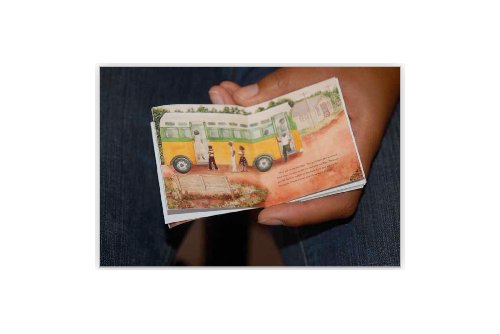
(Click to enlarge)
(Click to enlarge)
I am currently working on my next Lee & Low title, Sunday Shopping, written by Sally Derby. On the surface, it’s a charming story about a young girl and her grandmother, who have an imaginative cut-and-paste adventure with the Sunday paper. I’m excited to be in this story for a bit. It’s a nice departure from some of the more serious books that I have been working on, and I get to explore collage! It’s weird switching mediums sometimes, because when I think of what collage is, I think of Romare Bearden, Sean Qualls, and Chris Myers. I adore their work, but my goal is to use the medium in my own voice, so—like in Bird—it will be a marriage of the representational painting that I love to do with the more whimsical feeling of cut paper . . . in theory.
What happens in between theory and practice is often times very surprising. You have to allow room for that, too.
(Click to enlarge)
 All our food’s out (biscuits and coffee … mmm), and the table’s set now for seven questions over breakfast. Let’s get a bit more detailed, and I thank Shadra again for visiting 7-Imp.
All our food’s out (biscuits and coffee … mmm), and the table’s set now for seven questions over breakfast. Let’s get a bit more detailed, and I thank Shadra again for visiting 7-Imp.
1. Jules: What exactly is your process when you are illustrating a book? You can start wherever you’d like when answering: getting initial ideas, starting to illustrate, or even what it’s like under deadline, etc. Do you outline a great deal of the book before you illustrate or just let your muse lead you on and see where you end up?
Shadra: I begin every process with research. For books like Bird, Hurricanes, and White Water, I take a few days to explore the places where the story takes place. I walk the streets with my camera and sketchbook, collecting ideas and inspiration for the images. The more info I gather, the easier it is to express myself with the art. I also look at other artists and storytellers who have worked with similar subject matter.
But that’s only the bad side.”
(Click to enlarge.)
I looked to Ben Shahn, Jon Muth, and William Kentridge to answer questions about the art in Bird. Norman Rockwell inspired and challenged me for the Ruby Bridges piece in OCCS {Our Children Can Soar}. In APWHH {A Place Where Hurricanes Happen}, I turned to local artists Willie Birch and David Bates to get a sense of Gulf Coast life, pre-Katrina. I looked at Jerry Pinkney a lot while I was working on White Water.
(Click to enlarge spread.)
Once I have enough inspiration, I begin thumbnailing. I usually fill an entire sketchbook with ideas. The thumbnails are loose but give enough details for me, the art director, and editor to make sense of where I’m going visually and conceptually. After a couple of rounds, we agree on a final dummy and then the final work begins.
From there, I gather all of my references and blow up the thumbnails to working size to begin refining the drawings. Once the drawing is refined, I transfer it to paper and begin to paint or collage, etc. Each painting develops a bit differently. Depending on the illustration, I typically begin with the background. In a book like Bird, where the drawings carried a lot of the illustrations, I was able to paint the faces first. There’s really no one way to do it for me.
{Ed. Note: Shadra created this video for 7-Imp, all about her process.}
2. Jules: Describe your studio or usual work space.
Shadra: I recently moved to a lovely townhouse in Baltimore, MD. My studio is on the second floor. I have a drawing table, a long folding table for cutting, pasting, assembling, etc., an easel for larger paintings, an old G4 that I bought off of Craigslist for $300 (long live “the list”!), a large-format Epson printer, a laser printer, and flat files. Right now most of my picture book collection is still packed in boxes in my studio closet. I will be purchasing bookshelves very soon. My walls are cornflower blue, which deeply disturbs me. I prefer off white or cream walls, but I moved everything in before I had time to paint the studio. I’ll see if the urge hits me to re-paint this Fall.
I have had three different studio spaces in the past three years. I think my favorite was my tiny side room studio in Brooklyn. Because the space was small, I could sit in my chair and reach anything I needed from every direction. With larger rooms I have to get up and walk to another area to find something. In the middle of a painting, that can be very distracting. It’s also much too easy for me to be really messy and spread everything out. In the larger spaces, I do have to be very careful of how I set up my work space. My drawing table is usually in front of or next to a window for scenic relief throughout the day.
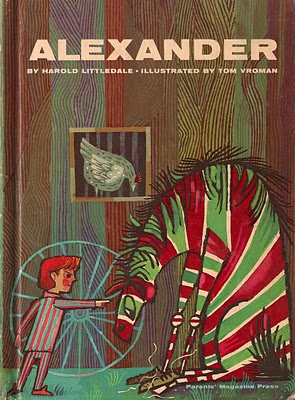 3. Jules: As a book lover, it interests me: What books or authors and/or illustrators influenced you as an early reader?
3. Jules: As a book lover, it interests me: What books or authors and/or illustrators influenced you as an early reader?
Shadra: As an early reader, I gravitated to a lot of informational early reader books, like, Where Does Rain Come From, How Does the Sun Work, etc. At home my mother would read Bible stories to me before bed. I loved my children’s Bible because of the rich, life-like illustrations (and it lived in a very special-looking box). I remember sitting underneath my grandmother’s glass table reading Alexander (by Harold Littledale, illustrated by Tom Vroman), while she and my mother would talk. I also read it in bed, in the tub, in the car. I was a bit obsessed. {Ed. Note: Illustrations pictured below.}
Of course, Peter was a bright spot in my world with his red coat and boots. A little later on I discovered Pat Cummings and Jerry Pinkney (largely due to Reading Rainbow). Because my mother taught high school English, I was fascinated with language. I graded her students’ vocabulary tests and was very familiar with Shakespere and other classics. I always sang, drew, read, and wrote for fun.

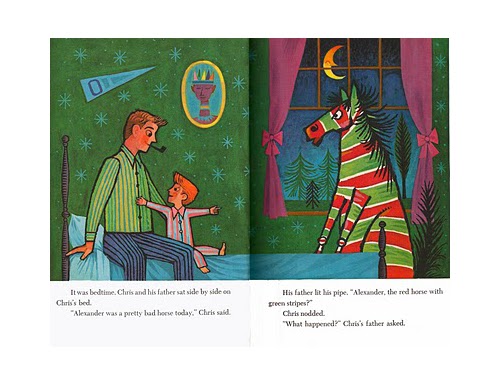
4. Jules: If you could have three authors or illustrators—whom you have not yet met—over for coffee or a glass of rich, red wine, whom would you choose?
Shadra: Luckily, I lived in New York for a while and had a chance to meet and hang out with a lot of my illustration heroes and heroines. If I could, though, I’d love to spend a day in the studio with The Dillons, Patricia Polacco, Tom Feelings, Jan Ormerod, Ashley Bryan, or Jon Muth.
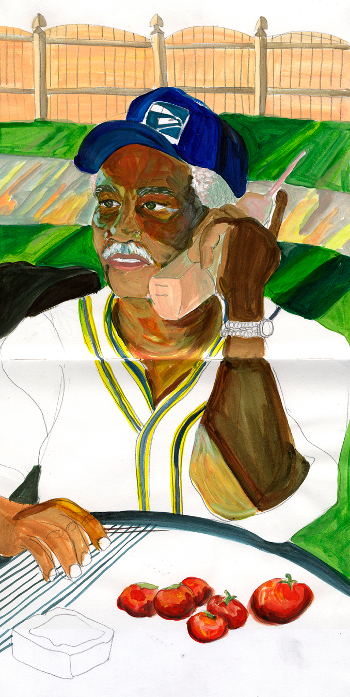 I’d bring Billy’s cupcakes and sit quietly and watch them work. That would be such a treat! I’m a naturally curious person, though. There really isn’t anyone I’d turn an opportunity down to eat cupcakes with and watch work.
I’d bring Billy’s cupcakes and sit quietly and watch them work. That would be such a treat! I’m a naturally curious person, though. There really isn’t anyone I’d turn an opportunity down to eat cupcakes with and watch work.
5. Jules: What is currently in rotation on your iPod or loaded in your CD player? Do you listen to music while you create books?
Shadra: Yes, I definitely listen to music when I work. I listen to music and sing all of the time. I am currently listening to Pandora when I work. My favorite stations are Amel Larrieux Radio, Goapele Radio, and Bilal Radio. I just d-loaded a bunch of J*Davey and recently discovered the wonders of Feist. Sometimes I create playlists specifically for the book I am working on. For example, when I was working on the art for A Place Where Hurricanes Happen, I listened to a lot of Terence Blanchard, specifically his A Tale of God’s Will album. It kept me in the mood while painting and drawing.
If I need to really concentrate—like now, for instance—I have to listen to smooth jazz or classical. I get too distracted by the lyrics, otherwise.
6. Jules: What’s one thing that most people don’t know about you?
Shadra: I love food…a lot. Nothing makes me happier than enjoying delicious food in interesting restaurants made by culinary artists. My favorite places to eat in Brooklyn are Enids, Le Petit Café, Red Bamboo, and Billy’s (Manhattan) for cupcakes. Here in Baltimore I enjoy Golden West Café, where they serve teriyaki brussel sprouts and banana cupcakes. For a high-end brunch experience and amazing cinnamon rolls, I recommend Alchemy.
Oh man, I’m getting hungry.
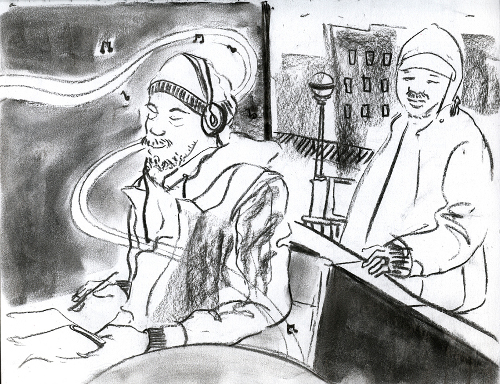
(Click to enlarge second one)
7. Jules: Is there something you wish interviewers would ask you — but never do? Feel free to ask and respond here.
Shadra: Nope, but here’s a simile that forever blew my mind from Arundhati Roy’s The God of Small Things: “A pale daymoon hung hugely in the sky and went where they went. As big as the belly of a beer-drinking man.”

Jules: What is your favorite word?
Shadra: “Yes.”
Jules: What is your least favorite word?
Shadra: “Hurry.”
Jules: What turns you on creatively, spiritually or emotionally?
Shadra: Great people.
Jules: What turns you off?
Shadra: Rudeness.
Jules: What is your favorite curse word? (optional)
Shadra: {My substitutes are} “cheese and rice!” and “shut the front door!”
Jules: What sound or noise do you love?
Shadra: Laughter.
Jules: What sound or noise do you hate?
Shadra: Loud crashes, like the clanging of pots and pans hitting the floor.
Jules: What profession other than your own would you like to attempt?
Shadra: Food critic or singer.
Jules: What profession would you not like to do?
Shadra: Data processor. I worked data entry during my summers off from college and could barely keep my eyes open.
Jules: If Heaven exists, what would you like to hear God say when you arrive at the Pearly Gates?
Shadra: “Catch your breath. I’m sending you back in.”
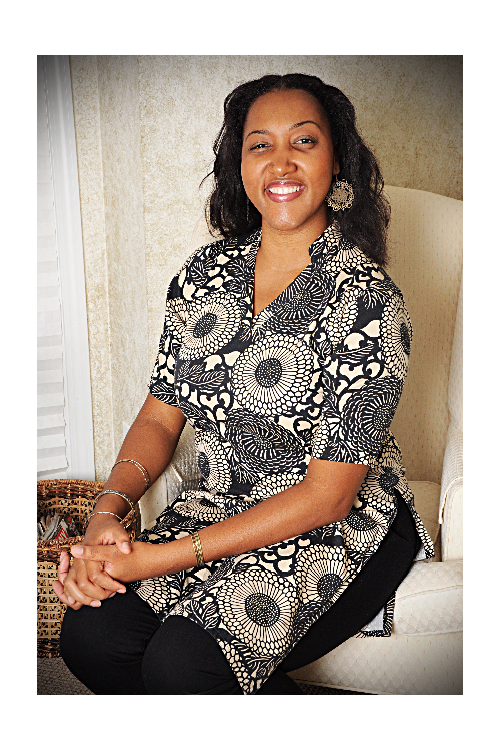
WHITE WATER. Text copyright © 2011 by Michael S. Bandy and Eric Stein. Illustrations copyright © 2011 by Shadra Strickland. Reproduced by permission of the publisher, Candlewick Press, Somerville, MA.
Spreads from A PLACE WHERE HURRICANES HAPPEN are © 2010 by Renée Watson. Illustrations © 2010 by Shadra Strickland. Re-printed from an earlier post. Published by Random House, New York, NY. Reproduced by permission of the illustrator.
OUR CHILDREN CAN SOAR. Illustration © 2009 by Shadra Strickland. Reprinted here from an earlier 7-Imp post and reproduced by permission of the publisher, Bloomsbury, New York, New York. All rights reserved.
Images from ALEXANDER are courtesy of Ms. Strickland.
All other artwork and images used with permission of Shadra Strickland. All rights reserved.
The spiffy and slightly sinister gentleman introducing the Pivot Questionnaire is Alfred, © 2009 Matt Phelan.
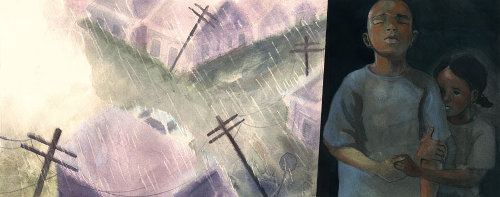
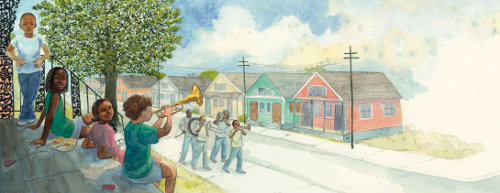
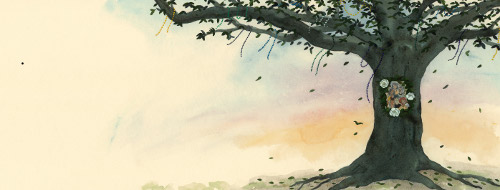

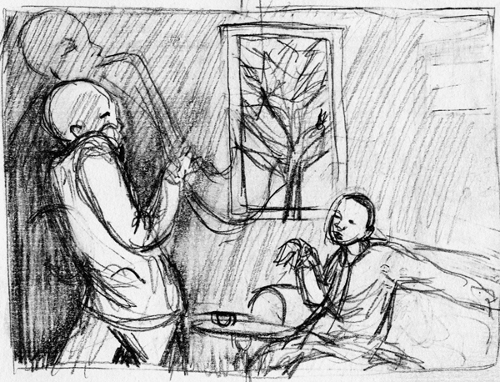

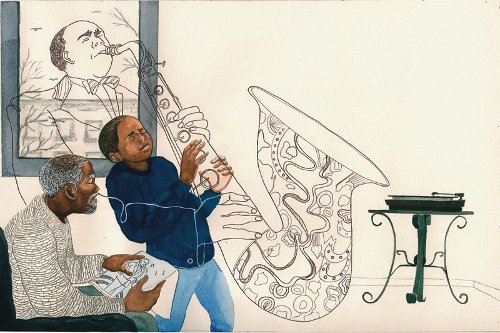



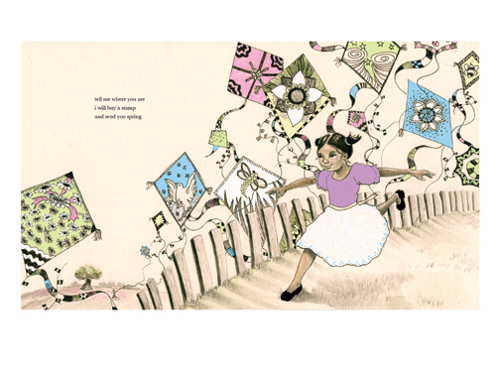

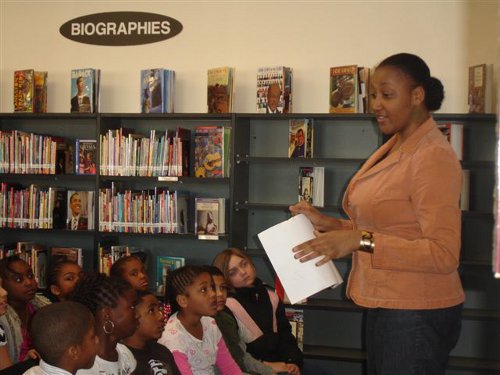
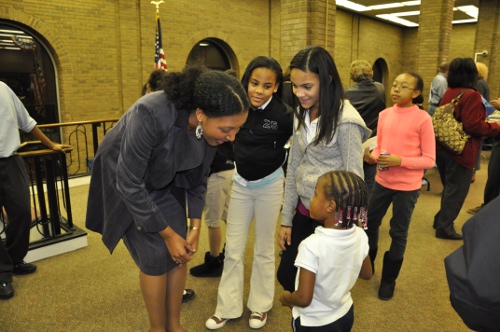
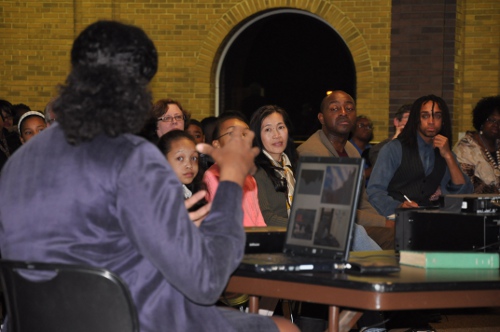


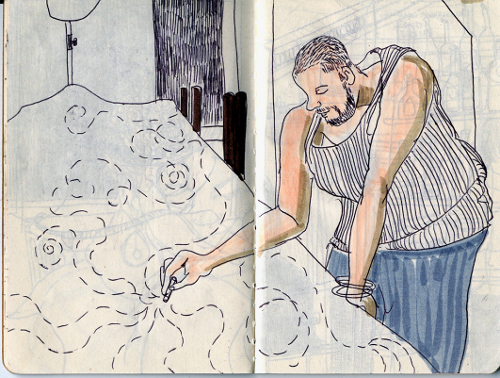
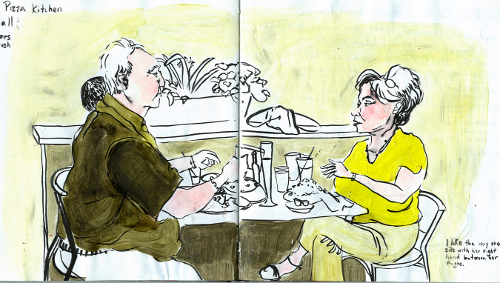
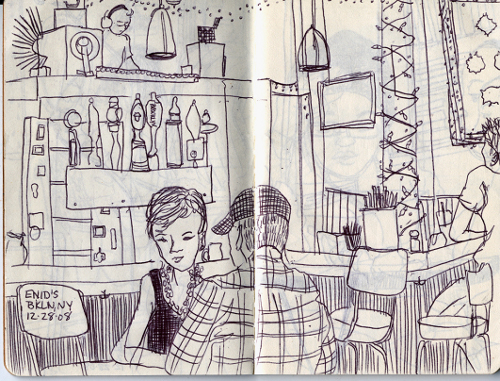
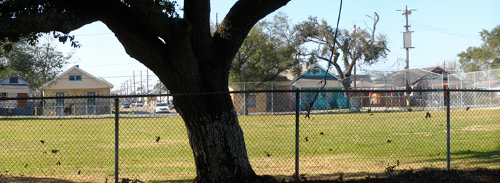
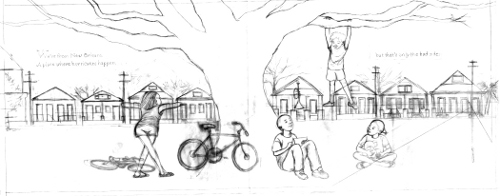
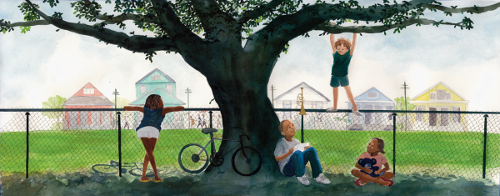
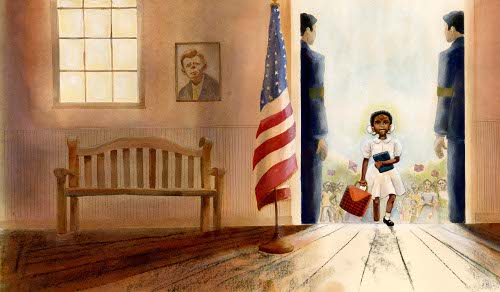
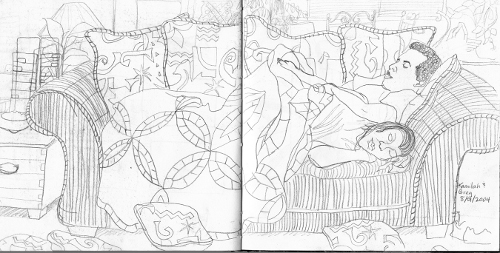

My dog, Xena, thinks it’s still Daylight Savings so I am up early. What a delightful person Shadra Strickland is! Her illustrations are full of heart. It was so very nice to begin my day meeting her. Thanks!
This was delightful from moment one to the end. First, I want to be as TALL as Shadra Strickland. Second, I want to have as cute a grin. But maybe most of all, I want to see as she does; she has such a way of looking at the world that she can render it magically in print and sketches. I love, love, LOVE that girl with the kites and the one splashing in the rain with the turtle.
Also? Cheese grits! I’ve never had them fried… must try this…
Yay Shadra! Congratulations for all the great work, and thanks for the shoutout! So nice to see all your great work together.
[…] on over to Seven Impossible Things Before Breakfast and have breakfast with me! There’s plenty of food and some art to boot! Thanks to Jules for […]
This post made me hungry! 🙂
Shadra, I could not be more proud of you!
Thanks everyone! And thanks Jules, for a wonderful breakfast 🙂
Great work (all of it)! I love your sketches and your personality. Thanks for sharing yourself with us. Inspiring.
[…] Shadra Strickland (November 8, 2011): “I begin every process with research. For books like Bird, Hurricanes, and White Water, I […]
Nice video you have on youtube
[…] From Shadra Strickland: […]
[…] Today’s the first Sunday of the month, so I welcome a student illustrator. Her name is Sairom Moon, and though she’s originally from South Korea, she comes to 7-Imp by way of her instructor at the Maryland Institute College of Art (MICA), illustrator Shadra Strickland. […]
[…] phenomenal draftswoman,” in the words of her instructor (and the award-winning illustrator) Shadra Strickland, who taught Elisabeth at the Maryland Institute College of Art. I believe Shadra also told me […]
[…] phenomenal draftswoman,” in the words of her instructor (and the award-winning illustrator) Shadra Strickland, who taught Elisabeth at the Maryland Institute College of Art. I believe Shadra also told me […]
[…] morning over at Kirkus, I chat with illustrator Shadra Strickland about her latest illustrated picture book, which you can spot in the photo above, as well as other […]
[…] week at Kirkus, I chatted with illustrator Shadra Strickland about her latest illustrated picture book, Toni and Slade Morrison’s Please, Louise (Paula […]
[…] illustration department that every semester I feel excited about choosing my classes. Among them, Shadra Strickland’s Book Illustration and Advanced Book Illustration courses have convinced me that children’s book […]
[…] in school, I took my first illustration class, a book illustration class taught by the fantastic Shadra Strickland, and everything made perfect sense. I loved the thrill of telling a story with images, of composing […]
[…] of April 2015) Today, I’m showcasing some artwork from illustrator Cannaday Chapman. Shadra Strickland shared Cannaday’s site via social media, and I went and saw and liked. Cannaday then gave me […]
[…] by Shadra Strickland: “Son, it is all too easy to let /this world’s bullies puncture your / pride […]